Carboxymethyl β-Cyclodextrin Assistance for the 4-Nitrophenol Reduction Using Cobalt-Based Layered Double Hydroxides
Abstract
1. Introduction
2. Results
2.1. Characterization of Cobalt-Based LDH
2.2. Reduction of 4-Nitrophenol in Aqueous Medium
2.3. Cobalt-Based LDH Recycling
3. Discussion
4. Materials and Methods
4.1. Chemicals
4.2. Synthesis of Materials
4.2.1. Synthesis of Carboxymethyl β-Cyclodextrin
4.2.2. Synthesis of Cobalt-Based LDH
- CoAl_CO3 LDH
- CoAl_CMβCD[X] LDH
4.3. Characterization Methods
4.3.1. Nuclear Magnetic Resonance Spectroscopy
4.3.2. Powder X-ray Diffraction
4.3.3. Thermogravimetric Analysis (TGA) Coupled with Differential Scanning Calorimetry (DSC)
4.3.4. Fourier Transform Infrared (FTIR) Spectroscopy
4.3.5. Scanning Electron Microscopy (SEM)
4.3.6. UV-Vis Spectrophotometry
4.4. 4-Nitrophenol Reduction Procedure in Aqueous Medium
5. Conclusions
Supplementary Materials
Author Contributions
Funding
Institutional Review Board Statement
Informed Consent Statement
Data Availability Statement
Acknowledgments
Conflicts of Interest
References
- Uberoi, V.; Bhattacharya, S.K. Toxicity and Degradability of Nitrophenols in Anaerobic Systems. Water Environ. Res. 1997, 69, 146–156. [Google Scholar] [CrossRef]
- Higson, F.K. Microbial Degradation of Nitroaromatic Compounds. In Advances in Applied Microbiology; Neidleman, S.L., Laskin, A.I., Eds.; Academic Press: Cambridge, MA, USA, 1992; Volume 37, pp. 1–19. [Google Scholar]
- Ariyarathna, T.; Twarz, S.; Tobias, C. Adsorption and Removal Kinetics of 2,4-Dinitroanisole and Nitrotriazolone in Contrasting Freshwater Sediments: Batch Study. Environ. Toxicol. Chem. 2023, 42, 46–59. [Google Scholar] [CrossRef] [PubMed]
- Huang, H.; Zhou, J.; Liu, H.; Zhou, Y.; Feng, Y. Selective Photoreduction of Nitrobenzene to Aniline on TiO2 Nanoparticles.Modified with Amino Acid. J. Hazard. Mater. 2010, 178, 994–998. [Google Scholar] [CrossRef] [PubMed]
- Tanaka, K.; Luesaiwong, W.; Hisanaga, T. Photocatalytic Degradation of Mono-, Di- and Trinitrophenol in Aqueous TiO2 Suspension. J. Mol. Catal. A Chem. 1997, 122, 67–74. [Google Scholar] [CrossRef]
- Dillert, R.; Brandt, M.; Fornefett, I.; Siebers, U.; Bahnemann, D. Photocatalytic Degradation of Trinitrotoluene and Other Nitroaromatic Compounds. Chemosphere 1995, 30, 2333–2341. [Google Scholar] [CrossRef]
- Formenti, D.; Ferretti, F.; Scharnagl, F.K.; Beller, M. Reduction of Nitro Compounds Using 3D-Non-Noble Metal Catalysts. Chem. Rev. 2019, 119, 2611–2680. [Google Scholar] [CrossRef]
- Lara, P.; Philippot, K. The Hydrogenation of Nitroarenes Mediated by Platinum Nanoparticles: An Overview. Catal. Sci. Technol. 2014, 4, 2445–2465. [Google Scholar] [CrossRef]
- Hamelian, M.; Varmira, K.; Karmakar, B.; Veisi, H. Catalytic Reduction of 4-Nitrophenol Using Green Synthesized Silver and Gold Nanoparticles over Thyme Plant Extract. Catal. Lett. 2023, 153, 2341–2351. [Google Scholar] [CrossRef]
- Liu, X.; Zhao, X.; Zhu, L.; Liu, N.; Tian, T. Palladium Nanoparticles Covered on Amine-Functionalized Mesoporous Hollow SiO2 Spheres for the Reduction of 4-Nitrophenol. Catal. Lett. 2018, 148, 173–180. [Google Scholar] [CrossRef]
- Reddy, P.L.; Tripathi, M.; Arundhathi, R.; Rawat, D.S. Chemoselective Hydrazine-Mediated Transfer Hydrogenation of Nitroarenes by Co3O4 Nanoparticles Immobilized on an Al/Si-Mixed Oxide Support. Chem. Asian J. 2017, 12, 785–791. [Google Scholar] [CrossRef]
- Fu, T.; Wang, M.; Cai, W.; Cui, Y.; Gao, F.; Peng, L.; Chen, W.; Ding, W. Acid-Resistant Catalysis without Use of Noble Metals: Carbon Nitride with Underlying Nickel. ACS Catal. 2014, 4, 2536–2543. [Google Scholar] [CrossRef]
- Kamal, T.; Ahmad, I.; Khan, S.B.; Ul-Islam, M.; Asiri, A.M. Microwave Assisted Synthesis and Carboxymethyl Cellulose Stabilized Copper Nanoparticles on Bacterial Cellulose Nanofibers Support for Pollutants Degradation. J. Polym. Environ. 2019, 27, 2867–2877. [Google Scholar] [CrossRef]
- Derikvand, Z.; Rahmati, F.; Azadbakht, A. Nano NiO/AlMCM-41, a Green Synergistic, Highly Efficient and Recyclable Catalyst for the Reduction of Nitrophenols. Appl. Organomet. Chem. 2019, 33, e4864. [Google Scholar] [CrossRef]
- Krawczyk, K.; Wacławek, S.; Silvestri, D.; Padil, V.V.T.; Řezanka, M.; Černík, M.; Jaroniec, M. Surface Modification of Zero-Valent Iron Nanoparticles with β-Cyclodextrin for 4-Nitrophenol Conversion. J. Colloid Interface Sci. 2021, 586, 655–662. [Google Scholar] [CrossRef] [PubMed]
- Mogudi, B.M.; Ncube, P.; Meijboom, R. Catalytic Activity of Mesoporous Cobalt Oxides with Controlled Porosity and Crystallite Sizes: Evaluation Using the Reduction of 4-Nitrophenol. Appl. Catal. B 2016, 198, 74–82. [Google Scholar] [CrossRef]
- Chen, H.; Yang, M.; Tao, S.; Chen, G. Oxygen Vacancy Enhanced Catalytic Activity of Reduced Co3O4 towards P-Nitrophenol Reduction. Appl. Catal. B 2017, 209, 648–656. [Google Scholar] [CrossRef]
- Chiu, H.-Y.; Wi-Afedzi, T.; Liu, Y.-T.; Ghanbari, F.; Lin, K.-Y.A. Cobalt Oxides with Various 3D Nanostructured Morphologies for Catalytic Reduction of 4-Nitrophenol: A Comparative Study. J. Water Process Eng. 2020, 37, 101379. [Google Scholar] [CrossRef]
- Liang, J.; Yue, A.; Wang, Q.; Song, S.; Li, L. Tailored Synthesis of Well-Faceted Single Crystals of Fe3O4 and Their Application in p-Nitrophenol Reduction. RSC Adv. 2016, 6, 29497–29503. [Google Scholar] [CrossRef]
- Wu, G.; Liang, X.; Zhang, L.; Tang, Z.; Al-Mamun, M.; Zhao, H.; Su, X. Fabrication of Highly Stable Metal Oxide Hollow Nanospheres and Their Catalytic Activity toward 4-Nitrophenol Reduction. ACS Appl. Mater. Interfaces 2017, 9, 18207–18214. [Google Scholar] [CrossRef]
- Kameliya, J.; Verma, A.; Dutta, P.; Arora, C.; Vyas, S.; Varma, R.S. Layered Double Hydroxide Materials: A Review on Their Preparation, Characterization, and Applications. Inorganics 2023, 11, 121. [Google Scholar] [CrossRef]
- Sun, H.; Xu, C.; Yang, X.; Tao, L.; Wang, Z.; Zhang, H.; Ji, X.; Ma, J.; Liu, L.; Tong, Z.; et al. Palladium Nanoparticles Supported on LDH: A Highly Efficient and Recyclable Heterogeneous Catalyst for the Heck Reaction. Appl. Clay Sci. 2023, 232, 106765. [Google Scholar] [CrossRef]
- Gupta, N.K.; Nishimura, S.; Takagakib, A.; Ebitani, K. Hydrotalcite-supported gold-nanoparticle-catalyzed highly efficient base-free aqueous oxidation of 5-hydroxymethylfurfural into 2,5-furandicarboxylic acid under atmospheric oxygen pressure. Green Chem. 2011, 13, 824–827. [Google Scholar] [CrossRef]
- Mitsudome, T.; Noujima, A.; Mizugaki, T.; Jitsukawa, K.; Kaneda, K. Efficient Aerobic Oxidation of Alcohols Using a Hydrotalcite-Supported Gold Nanoparticle Catalyst. Adv. Synth. Catal. 2009, 351, 1890–1896. [Google Scholar] [CrossRef]
- Tsuji, A.; Rao, K.T.V.; Nishimura, S.; Takagaki, A.; Ebitani, K. Selective Oxidation of Glycerol by Using a Hydrotalcite- Supported Platinum Catalyst under Atmospheric Oxygen Pressure in Water. ChemSusChem 2011, 4, 542–548. [Google Scholar] [CrossRef] [PubMed]
- Mizugaki, T.; Yamakawa, T.; Nagatsu, Y.; Maeno, Z.; Mitsudome, T.; Jitsukawa, K.; Kaneda, K. Direct Transformation of Furfural to 1,2-Pentanediol Using a Hydrotalcite-Supported Platinum Nanoparticle Catalyst. ACS Sustain. Chem. Eng. 2014, 2, 2243–2247. [Google Scholar] [CrossRef]
- Noujima, A.; Mitsudome, T.; Mizugaki, T.; Jitsukawa, K.; Kaneda, K. Selective Deoxygenation of Epoxides to Alkenes with Molecular Hydrogen Using a Hydrotalcite-Supported Gold Catalyst: A Concerted Effect between Gold Nanoparticles and Basic Sites on a Support. Angew. Chem. Int. Ed. 2011, 50, 2986–2989. [Google Scholar] [CrossRef]
- Motokura, K.; Fujita, N.; Mori, K.; Mizugaki, T.; Ebitani, K.; Kaneda, K. One-Pot Synthesis of α-Alkylated Nitriles with Carbonyl Compounds through Consecutive Aldol Reaction/Hydrogenation Using a Hydrotalcite-Supported Palladium Nanoparticle as a Multifunctional Heterogeneous Catalyst. Tetrahedron Lett. 2005, 46, 5507–5510. [Google Scholar] [CrossRef]
- Arora, N.; Mehta, A.; Mishra, A.; Basu, S. 4-Nitrophenol Reduction Catalysed by Au-Ag Bimetallic Nanoparticles Supported on LDH: Homogeneous vs. Heterogeneous Catalysis. Appl. Clay Sci. 2018, 151, 1–9. [Google Scholar] [CrossRef]
- Zhou, X.; Shi, J.; Bai, X. Ultrasonic Assisted Preparation of Ultrafine Pd Supported on NiFe-Layered Double Hydroxides for p-Nitrophenol Degradation. Environ. Sci. Pollut. Res. 2022, 29, 56178–56199. [Google Scholar] [CrossRef]
- Ma, H.; Wang, H.; Wu, T.; Na, C. Highly Active Layered Double Hydroxide-Derived Cobalt Nano-Catalysts for p-Nitrophenol Reduction. Appl. Catal. B 2016, 180, 471–479. [Google Scholar] [CrossRef]
- Leandro, S.R.; Marques, I.J.; Torres, R.S.; Fernandes, T.A.; Vaz, P.D.; Nunes, C.D. Nitroarene and Dye Reduction with 2:1 Co/Al Layered Double Hydroxide Catalysts—Is Gold Still Necessary? Inorg. Chim. Acta 2021, 521, 120336. [Google Scholar] [CrossRef]
- Szejtli, J. Introduction and General Overview of Cyclodextrin Chemistry. Chem. Rev. 1998, 98, 1743–1754. [Google Scholar] [CrossRef] [PubMed]
- Rekharsky, M.V.; Inoue, Y. Complexation Thermodynamics of Cyclodextrins. Chem. Rev. 1998, 98, 1875–1918. [Google Scholar] [CrossRef]
- Mohanambe, L.; Vasudevan, S. Structure of a Cyclodextrin Functionalized Anionic Clay: XRD Analysis, Spectroscopy, and Computer Simulations. Langmuir 2005, 21, 10735–10742. [Google Scholar] [CrossRef] [PubMed]
- Chalasani, R.; Vasudevan, S. Cyclodextrin-Functionalized Fe3O4@TiO2: Reusable, Magnetic Nanoparticles for Photocatalytic Degradation of Endocrine-Disrupting Chemicals in Water Supplies. ACS Nano 2013, 7, 4093–4104. [Google Scholar] [CrossRef] [PubMed]
- Moyo, L.; Nhlapo, N.; Focke, W.W. A Critical Assessment of the Methods for Intercalating Anionic Surfactants in Layered Double Hydroxides. J. Mater. Sci. 2008, 43, 6144–6158. [Google Scholar] [CrossRef]
- Ciobanu, A.; Ruellan, S.; Mallard, I.; Landy, D.; Gennequin, C.; Siffert, S.; Fourmentin, S. Cyclodextrin-Intercalated Layered Double Hydroxides for Fragrance Release. J. Incl. Phenom. Macrocycl. Chem. 2013, 75, 333–339. [Google Scholar] [CrossRef]
- Dhanasekaran, T.; Manigandan, R.; Padmanaban, A.; Suresh, R.; Giribabu, K.; Narayanan, V. Fabrication of Ag@Co-Al Layered Double Hydroxides Reinforced Poly(o-Phenylenediamine) Nanohybrid for Efficient Electrochemical Detection of 4-Nitrophenol, 2,4-Dinitrophenol and Uric Acid at Nano Molar Level. Sci. Rep. 2019, 9, 13250. [Google Scholar] [CrossRef]
- Kagunya, W.; Baddour-Hadjean, R.; Kooli, F.; Jones, W. Vibrational Modes in Layered Double Hydroxides and Their Calcined Derivatives. Chem. Phys. 1998, 236, 225–234. [Google Scholar] [CrossRef]
- Genty, E.; Cousin, R.; Capelle, S.; Gennequin, C.; Siffert, S. Catalytic Oxidation of Toluene and CO over Nanocatalysts Derived from Hydrotalcite-Like Compounds (X62+Al23+): Effect of the Bivalent Cation. Eur. J. Inorg. Chem. 2012, 2012, 2802–2811. [Google Scholar] [CrossRef]
- Mališová, M.; Horňáček, M.; Mikulec, J.; Hudec, P.; Jorík, V. FTIR Study of Hydrotalcite. Acta Chim. Slovaca 2018, 11, 147–156. [Google Scholar] [CrossRef]
- Ponchel, A.; Abramson, S.; Quartararo, J.; Bormann, D.; Barbaux, Y.; Monflier, E. Cyclodextrin Silica-Based Materials: Advanced Characterizations and Study of Their Complexing Behavior by Diffuse Reflectance UV–Vis Spectroscopy. Microporous Mesoporous Mater. 2004, 75, 261–272. [Google Scholar] [CrossRef]
- Egyed, O. Spectroscopic Studies on β-Cyclodextrin. Vib. Spectrosc. 1990, 1, 225–227. [Google Scholar] [CrossRef]
- Pérez-Ramírez, J.; Mul, G.; Kapteijn, F.; Moulijn, J.A. Investigation of the Thermal Decomposition of Co–Al Hydrotalcite in Different Atmospheres. J. Mater. Chem. 2001, 11, 821–830. [Google Scholar] [CrossRef]
- Trotta, F.; Zanetti, M.; Camino, G. Thermal Degradation of Cyclodextrins. Polym. Degrad. Stab. 2000, 69, 373–379. [Google Scholar] [CrossRef]
- Dalla Nora, F.B.; Lima, V.V.C.; Oliveira, M.L.S.; Hosseini-Bandegharaei, A.; de Lima Burgo, T.A.; Meili, L.; Dotto, G.L. Adsorptive Potential of Zn–Al and Mg–Fe Layered Double Hydroxides for the Removal of 2–Nitrophenol from Aqueous Solutions. J Environ. Chem. Eng. 2020, 8, 103913. [Google Scholar] [CrossRef]
- Omri, M.; Sauvage, F.; Busby, Y.; Becuwe, M.; Pourceau, G.; Wadouachi, A. Gold Catalysis and Photoactivation: A Fast and Selective Procedure for the Oxidation of Free Sugars. ACS Catal. 2018, 8, 1635–1639. [Google Scholar] [CrossRef]
- Omri, M.; Pourceau, G.; Becuwe, M.; Wadouachi, A. Improvement of Gold-Catalyzed Oxidation of Free Carbohydrates to Corresponding Aldonates Using Microwaves. ACS Sus. Chem. Eng. 2016, 4, 2432–2438. [Google Scholar] [CrossRef]
- Inoue, Y.; Okuda, T.; Miyata, Y.; Chûjô, R.N.M.R. Studies of Cycloamylose Inclusion-Complexes with p-Substituted Phenols. Carbohydr. Res. 1984, 125, 65–76. [Google Scholar] [CrossRef]
- Taviot-Guého, C.; Vialat, P.; Leroux, F.; Razzaghi, F.; Perrot, H.; Sel, O.; Jensen, N.D.; Nielsen, U.G.; Peulon, S.; Elkaim, E.; et al. Dynamic Characterization of Inter- and Intralamellar Domains of Cobalt-Based Layered Double Hydroxides upon Electrochemical Oxidation. Chem. Mater. 2016, 28, 7793–7806. [Google Scholar] [CrossRef]
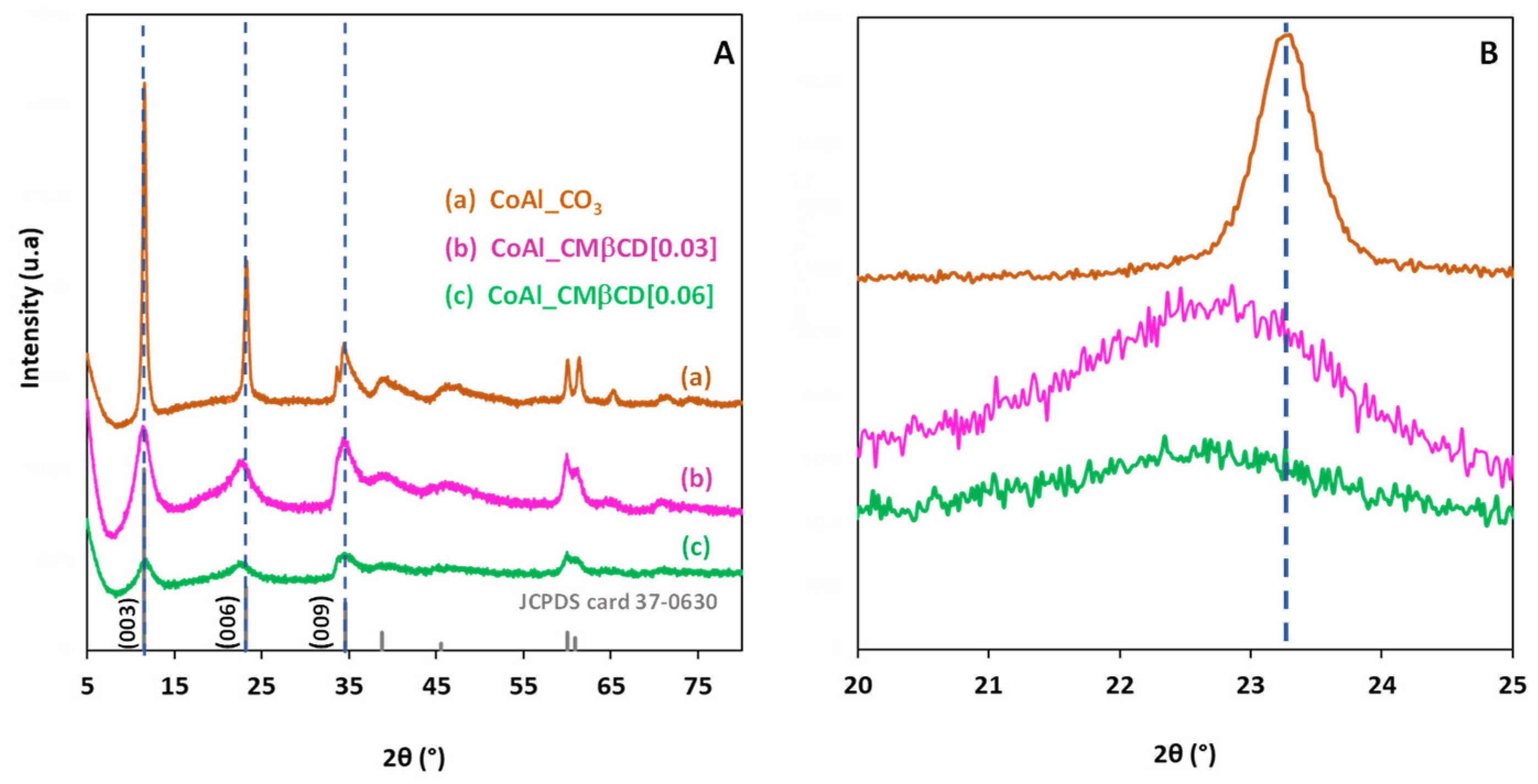
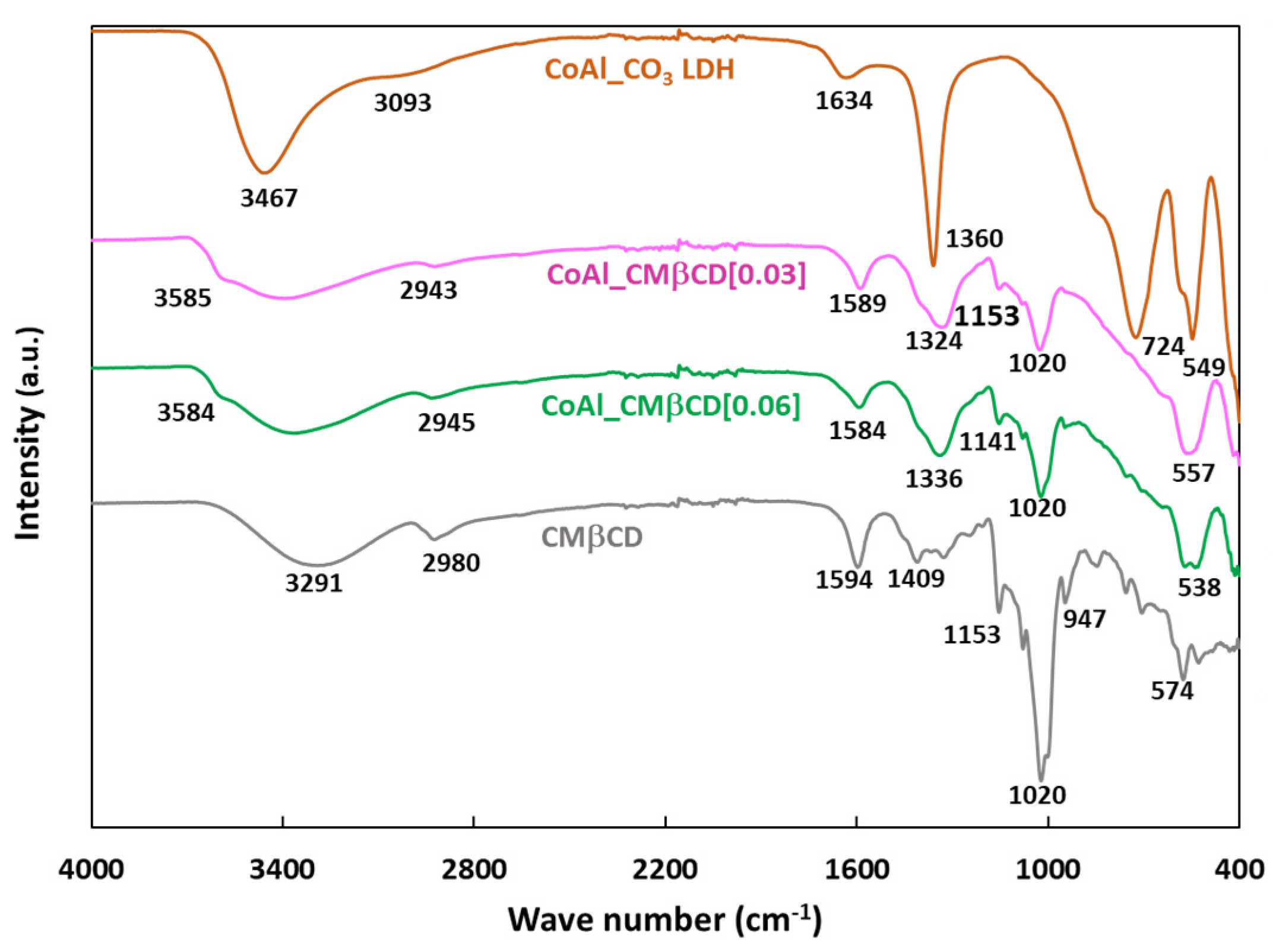
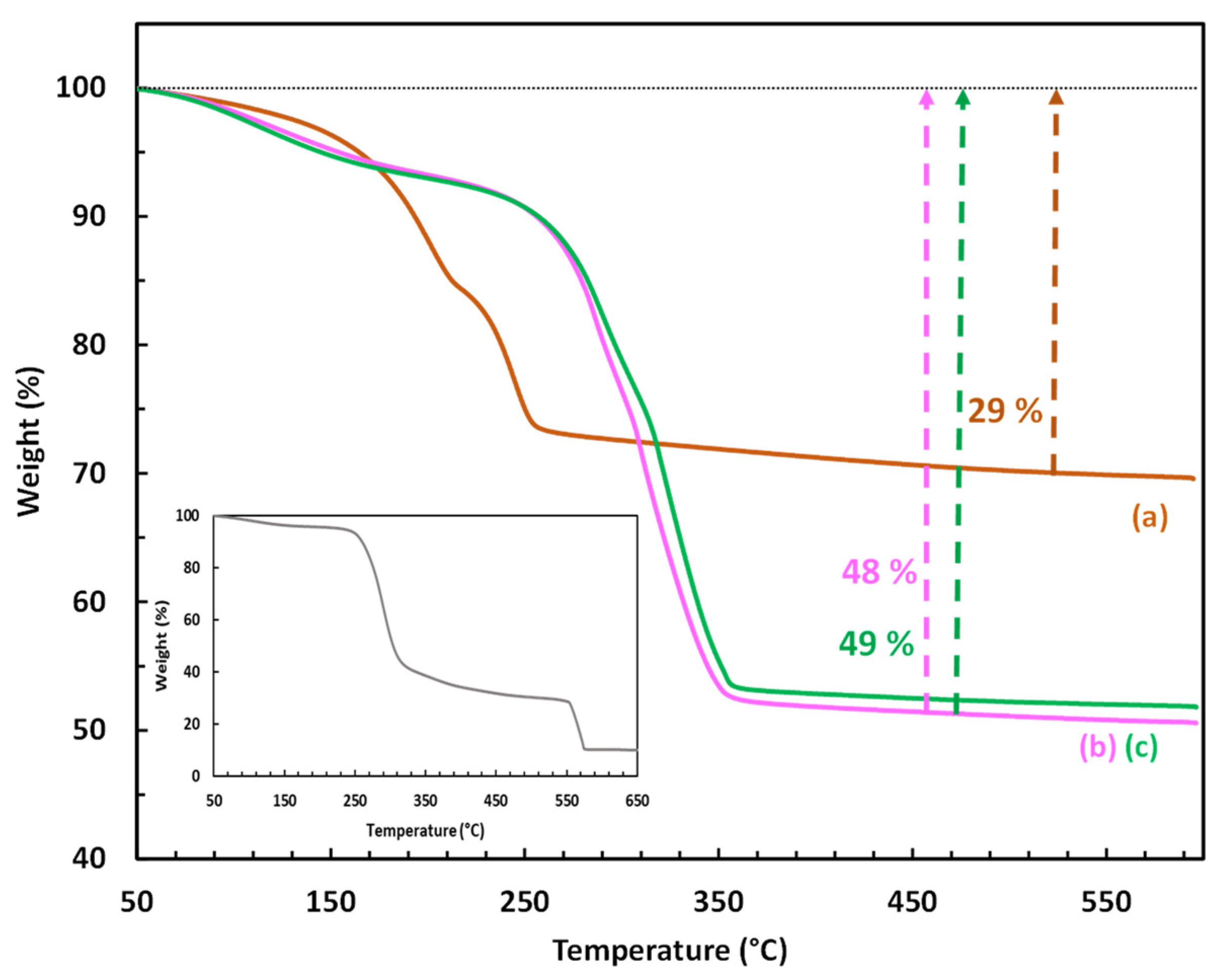

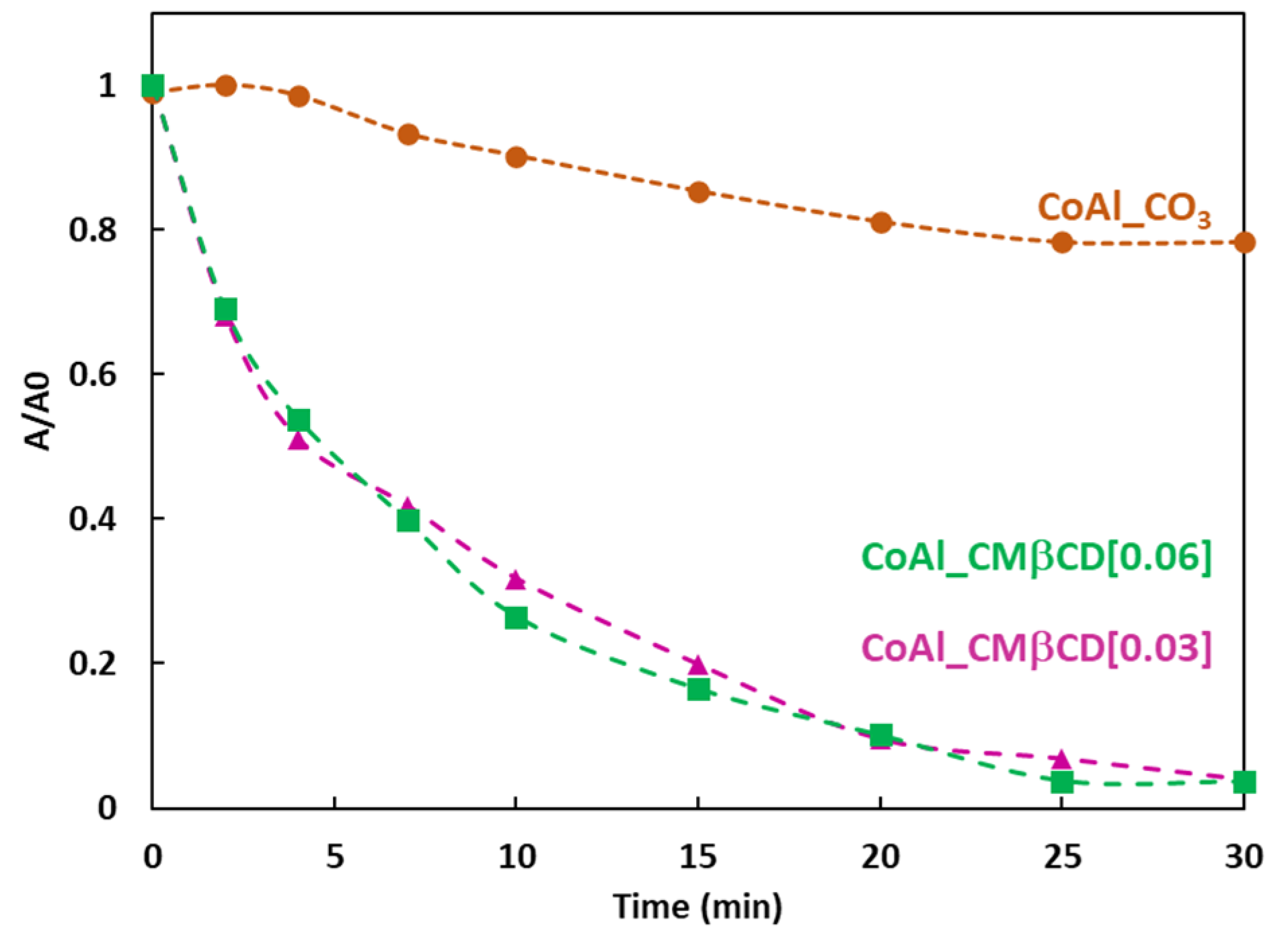
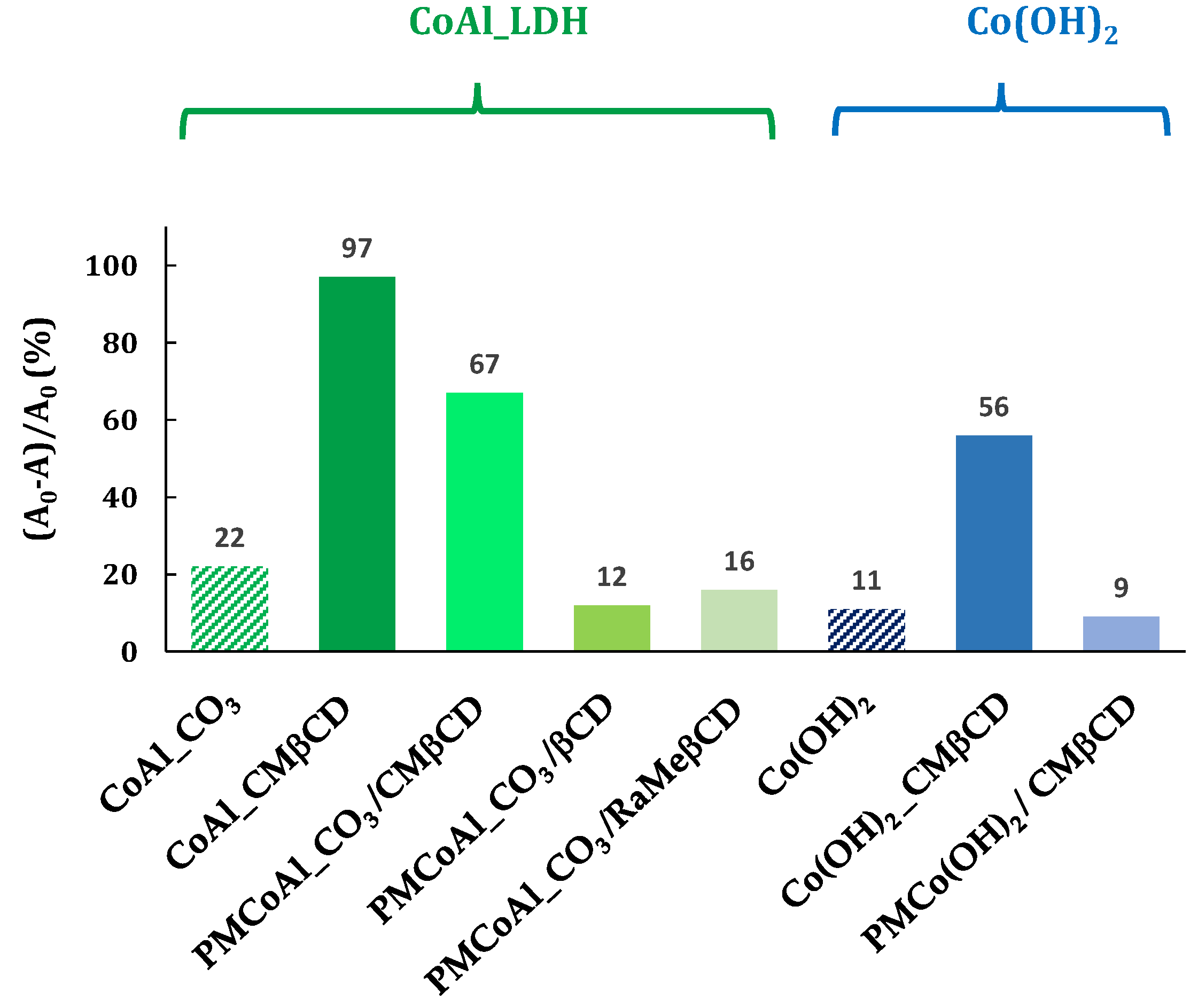
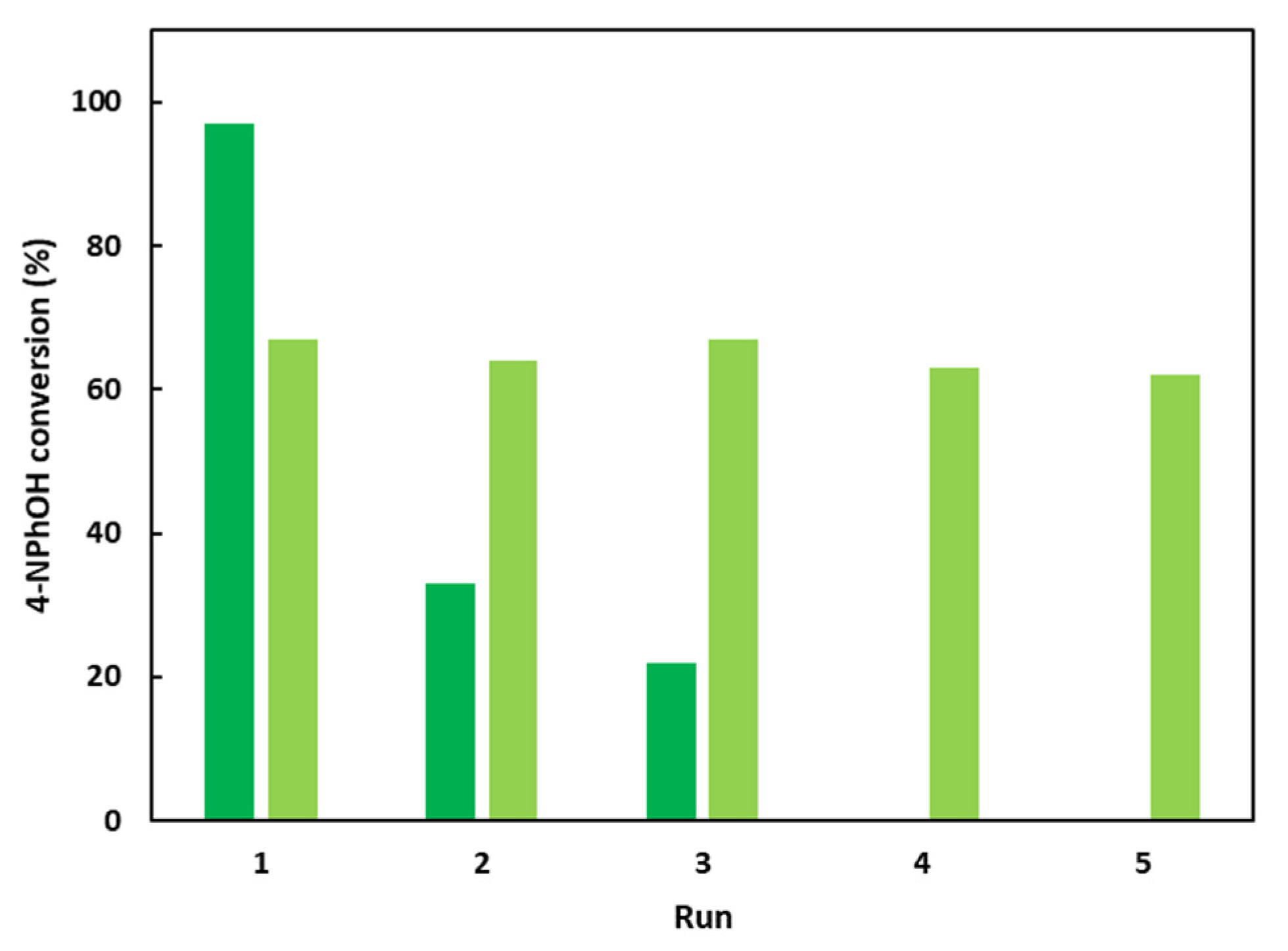
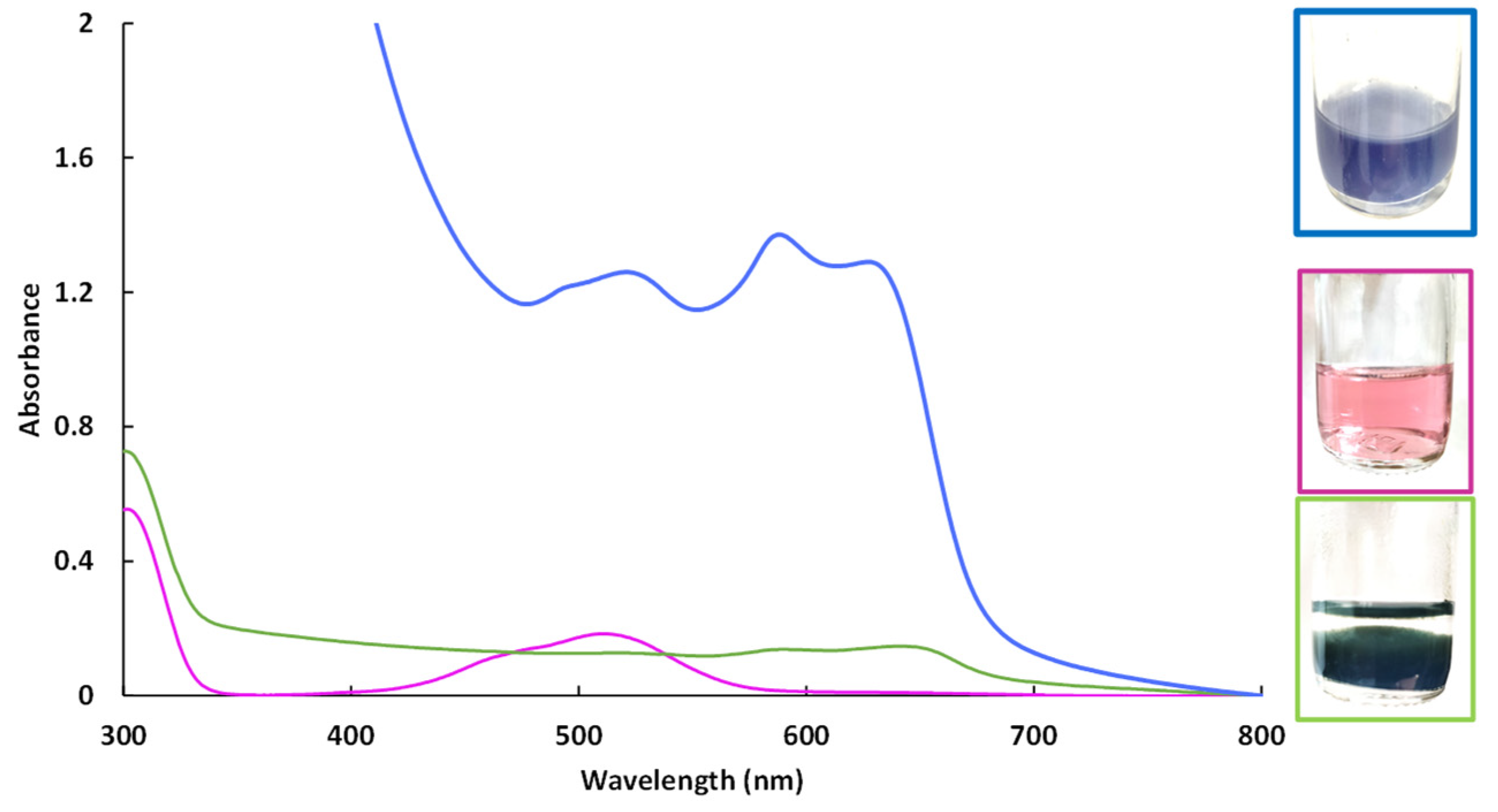
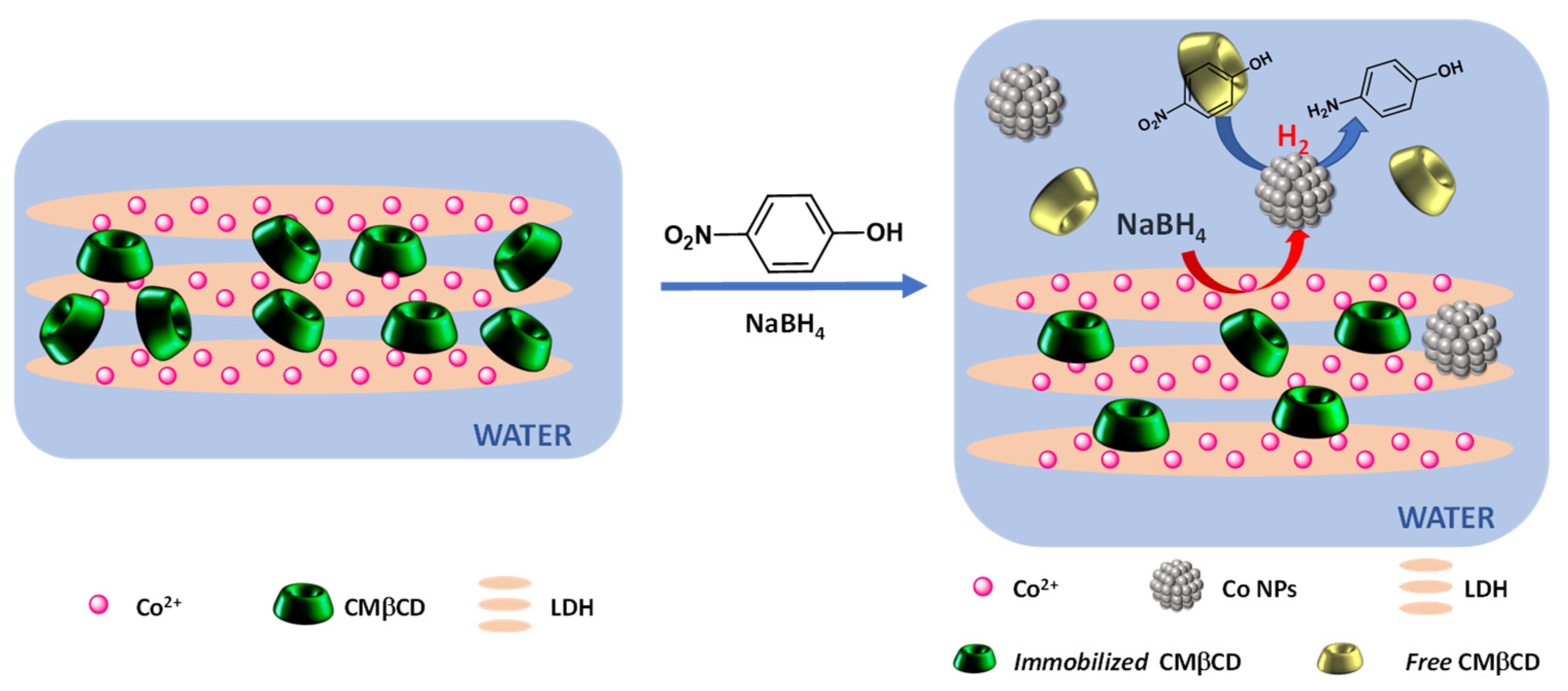
| Sample | wt % Co (*) | wt % Al (*) | wt % C (*) | wt % O (*) | wt % Na (*) | wt %Si (*) | wt % Cl (*) |
|---|---|---|---|---|---|---|---|
| CoAl_CO3 | 46.3 ± 0.9 (43.6) | 5.6 ± 0.1 (6.6) | 3.8 ± 0.2 (1.5) | 43.5 ± 1.1 (45.3) | 0.4 ± 0.01 | ||
| CoAl_CMβCD [0.03] | 39.3 ± 0.6 (31.5) | 5.2 ± 0.2 (4.8) | 13.5 ± 0.4 (13.2) | 40.3 ± 0.6 (49.9) | 1.0 ± 0.1 (0.6) | 0.7 ± 0.02 | |
| CoAl_CMβCD [0.06] | 38.6 ± 1.5 (30.3) | 4.8 ± 0.2 (4.6) | 13.7 ± 0.9 (14.6) | 41.5 ± 1.2 (49.8) | 1.0 ± 0.1 (0.7) | 0.5 ± 0.05 |
| Material | Molar Ratio NaBH4/4NPhOH | kapp (min−1) | Reference |
|---|---|---|---|
| Meso Co3O4 | 250 | 0.018 | [16] |
| Co3O4 | 100 | 0 | [17] |
| Reduced Co3O4 | 100 | 1.49 | [17] |
| CoAl_Cl | 100 | 0.064 * | [32] |
| CoAl_CMβCD | 100 | 0.116–0.121 | Our work |
Disclaimer/Publisher’s Note: The statements, opinions and data contained in all publications are solely those of the individual author(s) and contributor(s) and not of MDPI and/or the editor(s). MDPI and/or the editor(s) disclaim responsibility for any injury to people or property resulting from any ideas, methods, instructions or products referred to in the content. |
© 2024 by the authors. Licensee MDPI, Basel, Switzerland. This article is an open access article distributed under the terms and conditions of the Creative Commons Attribution (CC BY) license (https://creativecommons.org/licenses/by/4.0/).
Share and Cite
Demeester, A.; Douma, F.; Cousin, R.; Siffert, S.; Pourceau, G.; Wadouachi, A.; Ponchel, A.; Monflier, E.; Noël, S. Carboxymethyl β-Cyclodextrin Assistance for the 4-Nitrophenol Reduction Using Cobalt-Based Layered Double Hydroxides. Int. J. Mol. Sci. 2024, 25, 6390. https://doi.org/10.3390/ijms25126390
Demeester A, Douma F, Cousin R, Siffert S, Pourceau G, Wadouachi A, Ponchel A, Monflier E, Noël S. Carboxymethyl β-Cyclodextrin Assistance for the 4-Nitrophenol Reduction Using Cobalt-Based Layered Double Hydroxides. International Journal of Molecular Sciences. 2024; 25(12):6390. https://doi.org/10.3390/ijms25126390
Chicago/Turabian StyleDemeester, Alexia, Fatima Douma, Renaud Cousin, Stéphane Siffert, Gwladys Pourceau, Anne Wadouachi, Anne Ponchel, Eric Monflier, and Sébastien Noël. 2024. "Carboxymethyl β-Cyclodextrin Assistance for the 4-Nitrophenol Reduction Using Cobalt-Based Layered Double Hydroxides" International Journal of Molecular Sciences 25, no. 12: 6390. https://doi.org/10.3390/ijms25126390
APA StyleDemeester, A., Douma, F., Cousin, R., Siffert, S., Pourceau, G., Wadouachi, A., Ponchel, A., Monflier, E., & Noël, S. (2024). Carboxymethyl β-Cyclodextrin Assistance for the 4-Nitrophenol Reduction Using Cobalt-Based Layered Double Hydroxides. International Journal of Molecular Sciences, 25(12), 6390. https://doi.org/10.3390/ijms25126390











